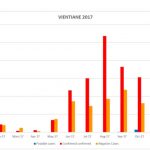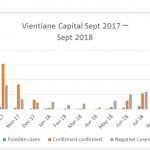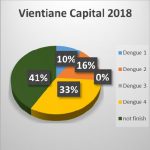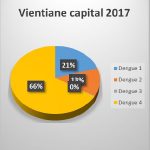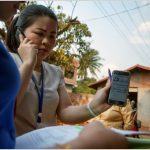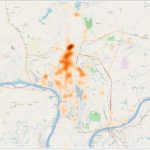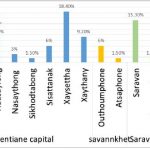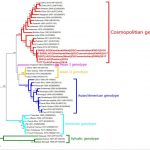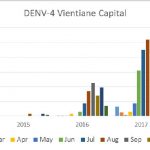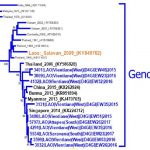Arbovirus surveillance – Ecomore2
Project funded by the French Development Agency (Agence Française du Développement (AFD))
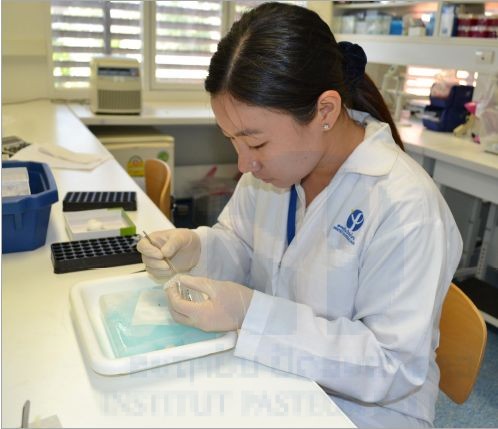
Project coordinator: Somphavanh Somlor
Member of staff: Thonglakhone Xaybounsou, Sitsana Keosenhom, Phaithong Bounmany
Background
The AEVD laboratory has been organizing a dengue surveillance system in Vientiane City for the last seven years. The data collected are shared in real time with clinical, municipality, and governmental health authorities. The standard procedures in place since the beginning of the surveillance provide reference data for the city. In the context of constant urban development, these data may help to anticipate epidemiologic changes in viral vector-borne diseases. The Ecomore2 project in the Lao PDR aims to reinforce the capacity to predict dengue epidemics by developing a multi-data-source modeling system. The dengue surveillance system provides the core of the data and the AEVD team coordinates the collection and control of the sources of supplementary data (such as entomological, socio-economic, environmental, and climatic data).
In the meantime, surveillance data were used to provide indicators to national and international health authorities to improve dengue prevention and control in 2018. Table 1 summarizes the parameters used to anticipate dengue transmission in Vientiane Capital in 2018.
Table 1: Surveillance-based parameters used to anticipate dengue virus transmission in Vientiane in 2018
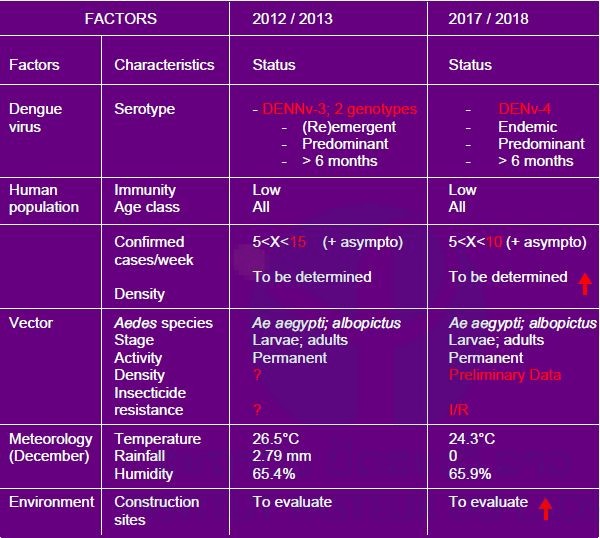
It has been assumed that, if meteorological conditions were appropriate for the development of vector populations, Vientiane Capital may experience an intense dengue virus transmission with a predominance of dengue virus serotype 4.
The IPL dengue surveillance network in Vientiane Capital has been reinforced over the past seven years to reach 14 hospitals (general public, private, and district hospitals) in 2018. A total of 884 suspected cases from 9 provinces (Vientiane Capital; Vientiane Province; Saravan; Attapeu; Luang Prabang; Xayabouly; Xieng Khouang; Champassack; Savannakhet) were investigated from January to September 2018. Most of them were collected by the hospital network in Vientiane Capital (557/884; 63%) but an increasing number of provinces, supported by different programs led by IPL (Ecomore2; Arboshield) are sending samples from dengue suspected cases.
For the third consecutive year, DENV-4 was found predominant in a context of the co-circulation of three of the four dengue virus serotypes (Figure n°4). A map of the distribution of dengue confirmed cases based on GPS coordinates of patients’ households revealed a main hot spot of density in Xaythani district in the extreme north of the city (Figure n°5).
However, the number of DENV-1 and DENV-2 cases recorded in the different districts of the capital city has increased significantly since August 2018 (Figure n°6). Preliminary genetic characterization of a panel of DENV-2 isolates obtained from autochthonous patients between 2016 and 2018 evidenced the presence of the “Cosmopolitan” genotype with a close link with a DENV-2 isolated from a Chinese patient returning from India (Figure n°6). Interestingly, DENV-2 viruses isolated in Vientiane Capital before 2015 belonged to the “Asian I” genotype. An increasing number of DENV-2 are now under investigation to further document the date of occurrence of this switch and better understand the routes by which the new genotype was introduced.
Figure 3: Dengue surveillance in Vientiane Capital 2017–2018
A) Monthly report of dengue cases in Vientiane Capital in 2017
B) Update of dengue transmission in Vientiane Capital from September 2017 to September 2018
Figure n°4: Comparison of dengue virus serotype proportions in Vientiane Capital over the last two years.
- Photo n°1: Field testing of a smartphone application for direct and secured transmission of GPS coordinates of dengue confirmed cases’ households to IPL server.
- Figure n°5: Densities of dengue confirmed cases in Vientiane City 2017–18.
- Figure n°6: Distribution of DENV-2 cases in Vientiane city districts (blue) and in three Southern provinces of Lao PDR (colors). The red star indicates a fatal case recorded in early October 2018 in Vientiane Capital.
- Figure n°7: Phylogeographic analysis of dengue virus serotype 2 in Vientiane Capital.
A genetic study of DENV-4 collected in Vientiane has also been initiated to determine the origin of the virus involved over the three consecutive years of the predominance of this serotype in the capital city (Figures 5, 8). Sequencing of the complete gene of the envelope protein established that the DENV-4 isolates circulating in Vientiane belonged to genotype I. Interestingly, the phylogeographic analysis revealed the co-circulation of two main clusters of isolates, one closely related to a Thai strain identified in 2006, and a second cluster linked to a strain from Singapore 2014 (Figure n°9). Imported cases bearing DENV-4 genotype II have been identified but this introduction event did not led to an autochthonous transmission of genotype II in Vientiane Capital. These data suggest that multiple introductions from different Asian countries helped maintain the DENV-4 genotype I in the Lao PDR.
Altogether, these studies on DENV-2 and DENV-4 in Vientiane highlight the importance of such information to follow the transmission of dengue virus in the Lao PDR and help in adjusting recommendations to stakeholders to improve control and prevention.
- Figure n°8: Distribution of DENV-4 over the five past years
- Figure n°9: Phylogeographic analyis of dengue virus serotype 4 in Vientiane Capital.
Of the number of suspected cases investigated, XX% were confirmed as an active dengue infection. Non-confirmed cases were tested for alternative etiologies such as Tahyna, chikungunya, or Zika virus. None of the 195 samples analyzed was found positive for the panel of arboviruses tested.

